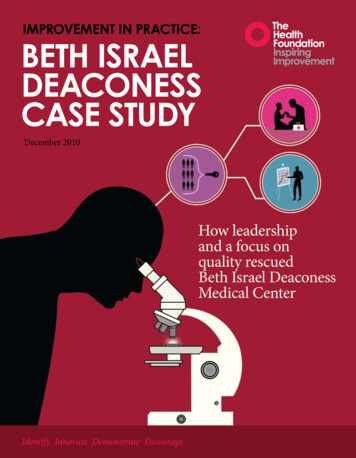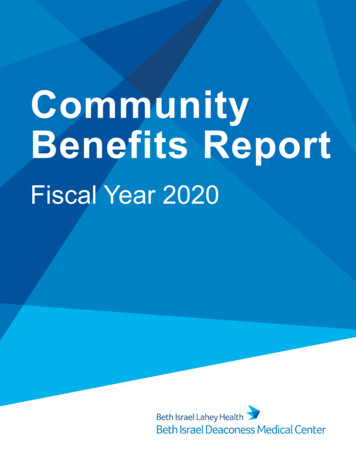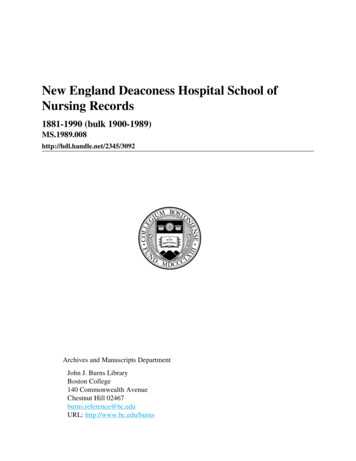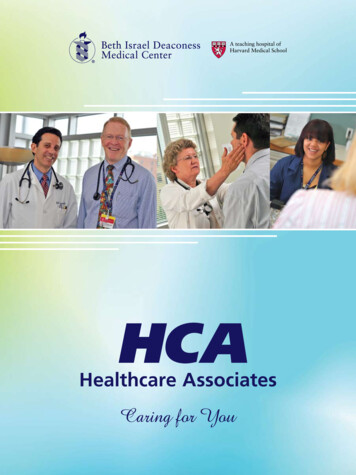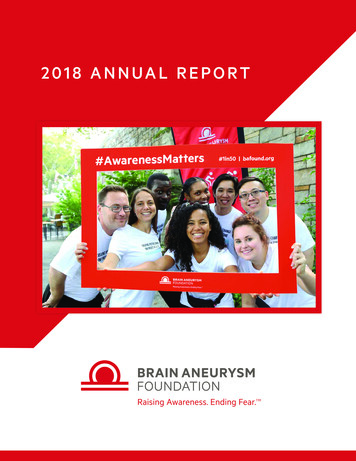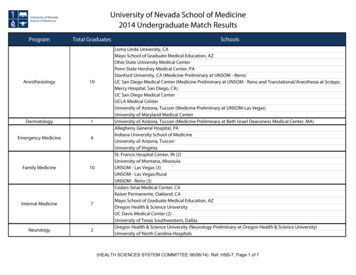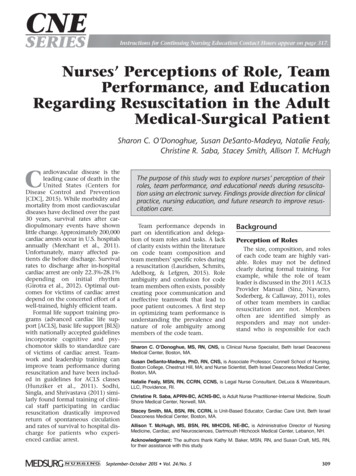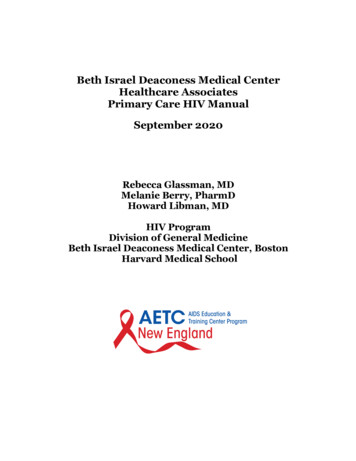
Transcription
Beth Israel Deaconess Medical CenterHealthcare AssociatesPrimary Care HIV ManualSeptember 2020Rebecca Glassman, MDMelanie Berry, PharmDHoward Libman, MDHIV ProgramDivision of General MedicineBeth Israel Deaconess Medical Center, BostonHarvard Medical School
Beth Israel Deaconess Medical CenterHealthcare Associates HIV ManualSeptember 2020Rebecca Glassman, MDAssistant Director, Primary Care TrackInstructor in Medicine, Harvard Medical SchoolMelanie Berry, PharmDHIV Ambulatory Clinical PharmacistHealthcare AssociatesHoward Libman, MDDirector, HIV ProgramProfessor of Medicine, Emeritus, Harvard Medical SchoolDivision of General MedicineBeth Israel Deaconess Medical Center, BostonPublication funded by The New England AIDS Education and Training Center, U.S.Department of Health and Human Services, Health Resources and ServicesAdministration, Federal Grant U1OHA29294.The recommendations contained in this monograph are based upon publishedguidelines for HIV-infected adults. Because the field of HIV disease is constantlyadvancing and standards of practice continue to evolve, practitioners should be familiarwith the current medical literature and request advice as necessary from cliniciansexperienced in the field.
Table of ContentsOverview1. HIV Testing and Counseling1-62. Initial Evaluation of Patients7-93. Stratified Management10-114. Antiretroviral Therapy12-195. Pneumocystis Pneumonia Prophylaxis20-236. MAC Infection Prophylaxis247. Immunizations25-278. Cervical and Anal Cancer Screening28-309. Tuberculosis31-3410. Viral Hepatitis35-3911. Sexually Transmitted Diseases40-4512. Long-Term Complications46-4913. HIV Prevention50-5514. HIV Drug Glossary56-93ReferencesComments are welcome and can be e-mailed to rglassma@bidmc.harvard.edu.
OverviewThe care of HIV-infected patients has undergone dramatic changes over the past twodecades with the use of combination antiretroviral therapy and viral load and resistancetesting in clinical practice. Patients are hospitalized less frequently with opportunisticinfections and are living longer. However, with this encouraging news have comeimportant challenges. For patients, they include long-term adherence to a medicalregimen and dealing with its potential toxicities. For health care practitioners, theyinclude keeping up with a changing but incomplete knowledge base and addressing theneeds of an aging population, some of whom may develop other chronic medical issues,as well as addressing HIV prevention effectively in primary care practice.The management of HIV disease lends itself to a primary care approach. Most successfulmodels are multidisciplinary, integrating case management, behavioral health, andpharmacists within the care team. In addition to history and physical examination, theinitial evaluation of HIV-infected patients should include assessment of their knowledgeof the disease and emotional state. Baseline laboratory studies are performed to screenfor occult disease and guide drug usage, to determine HIV disease status, and to look forevidence of concurrent infections. The CD4 cell count and viral load are essential forguiding therapeutic decisions.Antiretroviral therapy is recommended in all HIV-infected patients regardless of theirclinical status or CD4 cell count. There are both individual (decreased morbidity andmortality) and public health (decreased transmission) benefits of treatment. Therecommended initial regimen is a nucleoside reverse transcriptase inhibitor (NRTI) x 2plus an integrase inhibitor. Drug combinations over the past decade have consisted of adecreased number of pills that are dosed less frequently and associated with fewer sideeffects and long-term toxicities. Factors that may have a negative impact on adherenceshould be reviewed and addressed prior to initiation of therapy. Most patients willachieve viral suppression with their initial regimen, and the majority of these willcontinue to have undetectable virus on a long-term basis with good medicationadherence. The success rate often decreases with subsequent regimens. All HIV-infectedpatients, regardless of whether they are receiving antiretroviral therapy, should bemonitored with CD4 cell count and viral load tests. HIV resistance testing is indicatedwhen the viral load is not maximally suppressed on antiretroviral therapy.Complications have been associated with the long-term treatment of HIV infection. Theseinclude: 1) coronary artery disease; 2) premature bone loss; 3) lipodystrophy syndrome(body fat maldistribution, hyperlipidemia, glucose intolerance), mostly from exposure toolder NRTIs; 4) avascular necrosis of hips; 5) lactic acidemia/acidosis; and 6) peripheralneuropathy.
Opportunistic infection (OI) prophylaxis for PCP is indicated if the CD4 cell count is lessthan 200/mm3; TMP-SMX is the drug of choice. Prophylaxis for toxoplasmosis isindicated in patients with positive toxoplasmosis serology if the CD4 cell count is less than100/mm3. Prophylaxis for MAC infection is indicated in patients with chronic HIVinfection and CD4 cell count less than 50/mm3 if they are not virally suppressed. OIprophylaxis for these infections can often be safely discontinued following immunereconstitution with antiretroviral therapy.Routine health care maintenance issues in HIV-infected patients include immunizations(e.g., pneumococcal, hepatitis B, hepatitis A, influenza vaccines), periodic screening forconcurrent infections (e.g., viral hepatitis, syphilis, other sexually transmitted diseases,tuberculosis), regular Pap smears in women and anal Pap smears in at-risk populations,and other appropriate age- and sex-related screening interventions.COVID-19 and HIV InfectionLimited available data do not indicate that the disease course of COVID-19 (SARS-CoV2) in persons with HIV infection differs from that of seronegative individuals. However,it is important to remember that patients may have other risk factors for increasedmorbidity and mortality, including age 60 years, hypertension, diabetes mellitus,coronary artery disease, chronic obstructive pulmonary disease, and obesity.
Chapter 1. HIV Testing and CounselingBackgroundHealth care personnel in Massachusetts are required by statute to obtain verbal informedconsent from the patient or his/her health care proxy prior to HIV antibody testing. AnHIV antibody test can be ordered by a treating physician or authorized HIV counselor.Pretest and post-test counseling, while often useful, should not be barriers to testing. Allnewly diagnosed cases of HIV infection are reportable to the Massachusetts Departmentof Public Health.Epidemiology of HIV/AIDS and Risk of HIV TransmissionDespite advances in treatment, HIV infection remains a leading cause of morbidity andmortality. There are an estimated 1.1 million HIV-infected persons in the United States,and there were 37,832 new diagnoses in 2018. From 2010 to 2017, the number of newdiagnoses decreased by 11%; however in certain demographic groups, the numbers haveincreased. Gay and bisexual men are the most affected by HIV, accounting for 69% of allnew diagnoses and 86% of diagnoses in men.Despite significant advances in HIV testing and medical treatment, only 63% ofAmericans achieve viral suppression. Figure 1-1 from the Centers for Disease Control andPrevention (CDC) of the HIV care continuum depicts that a significant number of peopleliving with HIV drop off at each stage.In response to these sobering statistics, the CDC has launched the Ending the HIVEpidemic campaign with a goal to reduce new HIV infections by 90% by 2030. Thiscampaign is focused on three pillars: 1) ensuring patients are tested to know whether ornot they are infected; 2) providing treatment for those who are infected to ensure theirhealth and to reduce transmission; and 3) providing pre-exposure prophylaxis (PrEP) forthose who have an ongoing risk of acquiring HIV.1
Figure 1-1. HIV Infection in the United States: The Care osedReceiving CareVirally /hiv-vital-signs.htmlEstimated HIV Transmission Rate per Event by Exposure RouteParenteral Transfusion of contaminated blood Needle-sharing injection-drug use Occupational needle-stick exposureSexual Unprotected receptive anal intercourse Unprotected insertive anal intercourse Unprotected receptive vaginal intercourse Unprotected insertive vaginal intercourse Unprotected receptive oral intercourse Unprotected insertive oral .04%lowlow
These estimates are provided by the CDC. It is important to note that these figures areapproximate and may vary depending on the viral load of the source, the presence of othersexually transmitted diseases in both persons, male circumcision (for insertive vaginalintercourse), and other factors. Biting, spitting, and sharing sex toys are of negligible risk.GuidelinesThe CDC recommends inclusion of HIV antibody testing as part of the routine health careof adults and adolescents. The key points of these guidelines follow: All healthy adolescent and adult patients should be screened at least onceduring their lives after notification that an HIV test will be performed unlessthey decline (“opt-out” testing)Specific informed consent is unnecessaryPersons at high risk for HIV infection should be screened at least annuallyPrevention counseling should not be required as part of routine HIV testing,but it is encouraged for persons at high riskHIV antibody testing should never be construed by patients as coercive. As these federalrecommendations are implemented over time, the hope is that a higher percentage ofHIV-infected persons will become aware of their serostatus and that decreased HIVtransmission will result through a reduction in risk behaviors and the institution ofantiretroviral therapy.Traditional Indications for TestingHistorical Men who have sex with menPersons with multiple sexual partnersCurrent or past injection-drug users (IDUs)Recipients of blood products between 1978 and 1985Persons with current or past sexually transmitted diseasesCommercial sex workers and their sexual contactsPersons who have been sexually assaultedPersons who have had occupational exposuresPregnant women and women of childbearing ageChildren born to HIV-infected mothersSexual partners of those at risk for HIV infectionPersons who consider themselves at risk or request testingPersons infected with hepatitis B considering treatmentPersons considering pre-exposure prophylaxis (PrEP)3
Clinical TuberculosisSyphilisRecurrent or disseminated shinglesUnexplained chronic constitutional symptomsUnexplained generalized adenopathyUnexplained chronic diarrhea or wastingUnexplained encephalopathyUnexplained thrombocytopeniaThrush or chronic/recurrent vaginal candidiasisHIV-associated opportunistic diseases (e.g., Pneumocystis pneumonia,Kaposi's sarcoma)Suspected primary HIV syndromePrimary HIV infection is a nonspecific viral illness that occurs on average two weeks afterexposure and is characterized by fever, adenopathy, pharyngitis, rash, andmyalgia/arthalgia. It should be considered in the patient with a prolonged or atypicalviral illness or with an EBV (monospot)-negative mononucleosis syndrome. In thepatient with suspected primary HIV infection or recently acquired HIV infection, thefourth-generation HIV test (see below) should be adequate in most instances, but aconcurrent HIV viral load is recommended if the test is negative and there is a high clinicalindex of suspicion for the diagnosis. The viral load is often very high (e.g., millions ofcopies/ml) in this setting. It is important to note that low titer false-positive HIV viralload assays have been reported in persons with acute non-HIV-related illness.Contraindications to HIV Testing Inability of patient to understand implications of test resultAcute psychosis, major depression, or suicidalityLack of adequate personal support systemPotential Benefits and Risks of HIV Testing Individual health benefits include antiretroviral therapy, prophylaxis foropportunistic infections, screening and prophylaxis for tuberculosis, screening forand treatment of syphilis and other sexually transmitted diseases, administration ofappropriate vaccinations, and institution of other health care maintenance measures.Public health benefits include decrease in HIV transmission through identification ofprimary HIV infection, reduction of high-risk behaviors and lowering of viral loads,and monitoring of HIV infection epidemiology.Risks include false-positive test result, false-negative test result, adversepsychological reactions, breach of confidentiality, and social discrimination.4
Pretest CounselingPretest counseling often includes the following: Distinguishing between anonymous and confidential testing and discussingthe availability of home-testing kitReviewing natural history of HIV infectionReviewing reasons for testing and expectationsReviewing individual risk behaviors and risk-reduction measuresDiscussing meaning of positive and negative resultsAssessing personal and social supportsHIV Diagnostic TestingEarlier HIV testing consisted of antibody testing using an enzyme-linked immunosorbentassay (ELISA) followed by a confirmatory Western blot (WB) test. A fourth-generationassay, which detects both the HIV p24 antigen and HIV 1 and 2 antibodies, is nowrecommended by the CDC (Figure 1-2). The inclusion of the p24 antigen narrows the“window period” where HIV antibody may not yet be detected and increases thelikelihood of diagnosing acute HIV infection.Rapid immunoassay tests that detect HIV antibody (e.g. OraQuick) in blood or oral fluidwithin 20 minutes have been developed. A positive rapid HIV antibody test should stillbe confirmed with the more specific WB. A newer rapid immunoassay (Alere Determine)detects HIV p24 antigen and HIV 1 and 2 antibodies within 20 minutes. These enableclinicians to provide definitive negative and preliminary positive results immediately.5
Figure 1-2. HIV Testing Algorithm with 4th Generation ImmunoassayCenters for Disease Control and Prevention. Detection of acute HIV infection in two evaluations of a newHIV diagnostic testing algorithm - United States, 2011-2013. MMWR 2013; 62:489.Risk Reduction CounselingRisk reduction counseling is an important component of both pretest and post-testcounseling. It should include the following advice: Reduce or limit the number of sexual partnersUse latex condoms with water-based lubricant for all sexual activityConsider initiation of PrEP if at ongoing high risk (see Chapter 12)Detoxification or methadone maintenance program for IDUsUse sterile needles; however, if equipment is shared, make sure it is cleanedwith bleach as recommendedDo not share personal items such as razors and toothbrushes6
Chapter 2. Initial Evaluation of PatientsHistoryIn addition to reviewing the past medical and family medical histories, medications(prescription, OTC, and complementary drugs), and allergies of the patient with newlydiagnosed HIV infection, the following issues should be addressed: HIV risk behaviors (sexual and drug use)Knowledge of HIV infectionEmotional response to diagnosisFamily and social situationEmployment and insurance statusTravel historyExposure to tuberculosis, syphilis, other sexually transmitted diseases, andviral hepatitis (A, B, and C)Status of immunizationsIn the patient with established HIV infection followed previously by another practitioner,knowledge of prior opportunistic diseases, CD4 cell counts (nadir and recent), HIV viralload results (highest and recent), and antiretroviral therapy chronology, including drugsused and reasons for their discontinuation, are also important. Prior HIV genotypesshould also be obtained to determine the full spectrum of resistance mutations.Review of Systems and Physical ExaminationAttention should focus on the following organ system symptoms and signs and onscreening for HIV-related conditions: Constitutional symptoms: fever, chills, night sweats, weight lossIntegument: seborrhea, psoriasis, onychomycosis, herpes simplex virus,varicella-zoster virus, Kaposi's sarcoma, generalized adenopathyHEENT: altered vision, dysphagia, cytomegalovirus (CMV) retinitis, thrush,oral hairy leukoplakia, periodontal diseasePulmonary: cough, dyspnea, evidence of pneumoniaGastrointestinal: odynophagia, diarrhea, organomegaly, anal condyloma/dysplasia/carcinomaGenitourinary: vaginitis, pelvic inflammatory disease, genital warts,cervical dysplasia/carcinomaNeurological: headache, problems with memory, change in behavior orpersonality, focal abnormalities7
Laboratory StudiesBaseline laboratory evaluation is performed to assess for organ system dysfunction, tostage and monitor HIV disease, and to screen for other important disorders.Recommended studies include the following: Complete blood and differential countsGlucose, BUN/creatinine, liver function testsHgbA1c and fasting lipid profileUrinalysisCD4 cell count (see below)HIV viral load (see below)HIV genotype testSyphilis serology (treponemal or nontreponemal test)Anti-HAVHepatitis B serologiesAnti-HCVToxoplasmosis (IgG) serologyPPD or gamma-interferon release assayCervical Pap smear in women (see Chapter 8)Anal Pap smear in persons at risk (see Chapter 8)Chlamydia and GC assays in persons at risk in exposed body locations(urethra, vagina, cervix, rectum, throat)HLA-B*5701 testing should be performed prior to initiating abacavir therapy as patientswho test positive have a high risk of hypersensitivity reaction to this drug. A G6PDqualitative screening test (if Pneumocystis jirovecii (carinii) pneumonia [PCP]prophylaxis with dapsone is contemplated) and CMV IgG antibody test (if bloodtransfusions are anticipated) are also appropriate. It may be reasonable to perform achest x-ray in some clinical circumstances (e.g., history of injection-drug use).The following tests are important for the staging and monitoring of HIV disease:CD4 Cell Count Main surrogate marker for HIV disease progressionNormal range is 350 to 1100/mm3; there is average decline of 75-100/mm3per year without treatment but variability between patients and in a givenpatient over timeIntercurrent illnesses may transiently affect valueThere is some inter-laboratory variability, so use caution in interpretingwidely disparate values8
Clinical uses are to determine need for antimicrobial prophylaxis and toassess prognosisHIV Viral Load Measurement of viral RNA in plasma by polymerase chain reaction (PCR)Lower limit of detection of ultrasensitive PCR assay is 20 copies/mlNote that some viral load results may be reported as log 10 copies/ml (20copies/ml 1.3 log 10 copies/ml)High level correlates with CD4 cell count decline and clinical diseaseprogressionNormal variability of 0.3 log (three- to five-fold)Intercurrent illnesses and immunizations may transiently affect valueClinical uses are to monitor antiretroviral therapySpectrum of HIV DiseasePatients are at risk for complications at the following CD4 cell count thresholds:CD4 Cell Count 500/mm3 Most patients asymptomatic Bacterial infections (e.g., pneumococcal), pulmonary tuberculosis, shingles,other dermatologic conditionsCD4 Cell Count 500-200/mm3 Many patients asymptomatic Generalized adenopathy, thrush, Kaposi’s sarcomaCD4 Cell Count 200/mm3 PCP, toxoplasmosis, cryptococcosisCD4 Cell Count 50/mm3 CMV and Mycobacterium avium complex infections Increased risk of lymphoma Most deaths occur in this rangeIt is important to note that the risk for a specific opportunistic disease increases the longerthe CD4 cell count is below threshold and the more it drops below that level. For instance,the risk of a patient developing PCP is far greater if the CD4 cell count is 200/mm3 forthree months than it is if the CD4 cell count is 200/mm3 for one week.The CD4 percentage (CD4 count/total lymphocyte count) may be useful adjunctively inclinical settings in which the CD4 cell count may not accurately reflect the patient’simmune status (e.g., anatomic or functional asplenism).9
Chapter 3. Stratified ManagementSpecific management considerations in HIV-infected patients include initiation andcontinuation of antiretroviral therapy, antimicrobial prophylaxis against opportunisticinfection, and health care maintenance issues.All patients with newly diagnosed HIV infection regardless of CD4 count should be startedon antiretroviral therapy (see Chapter 4).If the CD4 count is 200/mm3, pneumocystis prophylaxis should also be initiated (seeChapter 5). Trimethoprim-sulfamethoxazole (TMP-SMX) is the drug of choice. Dapsone,atovaquone, and aerosol pentamidine are alternatives. TMP-SMX is also effective fortoxoplasmosis prophylaxis, which is initiated in the patient with CD4 cell count 100/mm3 and a positive toxoplasmosis serology. Alternative toxoplasmosis prophylaxisin TMP-SMX allergic patients is dapsone with pyrimethamine plus folinic acid.MAC prophylaxis is no longer recommended in patients with a new diagnosis of HIVinfection who immediately start antiretroviral therapy (see Chapter 6). However, it is stilladvised in patients with chronic HIV infection who are not virally suppressed.Primary prophylaxis against coccidioidomycosis and histoplasmosis may be indicated inpatients with a low CD4 cell count who live in endemic areas. See published guidelinesfor more information.Follow-up VisitsMedical visits should be scheduled with appropriate frequency to monitor for diseaseprogression and complications and to monitor drug therapies. In general, patients withadvanced HIV disease require more frequent visits than those with earlier stages.Initial evaluation is generally accomplished in two visits over a short interval. At the first,a history and physical examination are performed, and baseline laboratory studies areobtained. At the second, results of evaluation are reviewed, and a management plan isdiscussed. Issues to be addressed should include any active medical problems,opportunistic infection prophylaxis, antiretroviral therapy, health care maintenance, andpatient education.After antiretroviral therapy is initiated, a follow-up visit is arranged in four weeks toassess tolerability of medication regimen and to repeat laboratory parameters used todetermine its effectiveness. Once a patient is on a stable treatment regimen, follow-upvisits every three to six months are recommended unless intercurrent problems requiremore frequent appointments.10
Laboratory TestingOnce patients are on a stable antiretroviral regimen, laboratory evaluation at follow-upvisits should include the following:TestComplete blood and differential countsBUN/creatinine, liver function testsHgbA1c and fasting lipid profileCD4 cell countHIV viral loadSexually transmitted diseasesIntervalEvery 3-6 monthsEvery 3-6 monthsOnce per year if normalEvery 3-12 monthsEvery 3-6 monthsAt least annually(evaluate risk at each visit)At least annuallySee Chapter 8Hepatitis C infectionCervical and anal cancer screeningRegarding CD4 count CD4 count response to antiretroviral therapy varies widely, but a poor response israrely an indication for modifying regimenIn patients with suppressed viral loads who are immune reconstituted, the CD4count provides limited informationCD4 count testing is recommended at baseline and every 3 to 6 months thereafterIt may be extended to every 12 months in patients who are clinically stable with asuppressed viral load for 2 years and is optional for those with CD4 count 500/mm3 in this settingRegarding HIV viral load For most individuals who are adherent to their antiretroviral regimens and who donot harbor resistance mutations to the prescribed drugs, viral suppression isgenerally achieved in 12 to 24 weeksViral load testing is recommended at baseline, 2 to 4 weeks after ART initiation,every 4 to 8 weeks until the viral load is suppressed, and every 3 to 4 monthsthereafterIt may be extended to every 6 months in patients with a suppressed viral load for 2 years11
Chapter 4. Antiretroviral TherapyBackgroundThe past two decades have shown great advances in the management of HIV disease withalmost all patients benefiting from antiretroviral therapy. The followingrecommendations are based on our current understanding of the pathophysiology of HIVdisease and the results of clinical trials. They reflect the guidelines of US Department ofHealth and Human Services. Because of the changing nature of clinical practice in thisarea, expert consultation should be sought when initiating or changing drug regimens.Pathophysiology of HIV InfectionViral replication occurs throughout the course of HIV infection at very high rates. It isestimated that 1010 viral particles are produced each day. The patient's immune systemkeeps pace with this activity during the clinical latency period. However, in the absenceof effective antiretroviral treatment, the immune system ultimately reaches a "point ofexhaustion," at which viral replication exceeds its ability to produce CD4 cells. This leadsto a decline in immunologic function and the development of clinical manifestationsincluding opportunistic infections and neoplasms.The rate of viral replication is thought to stabilize after primary infection at a particularlevel or "set point." This level may be maintained within a ten-fold range over monthsand possibly years. The viral load is highly correlated with the rate of disease progressionand mortality.General GuidelinesThe primary goal of antiretroviral therapy is to keep the viral load as low as possible foras long as possible. Maximal suppression of the virus makes it more difficult forresistance to develop. Partial suppression results in the emergence of resistant mutantstrains in the viral population. These are present because of the rapid turnover of HIVand the many random errors made during replication. They predominate in the contextof ineffective treatment because of a competitive advantage over pansensitive (“wildtype”) virus.Three-quarters of patients or more will achieve maximal viral suppression with theirinitial regimen, and the majority of these will continue to have undetectable virus on along-term basis with good medication adherence. The success rate often decreases withsubsequent regimens. Current antiretroviral regimens are not curative probably becauseof persistence of HIV in quiescent CD4 lymphocytes and because of "sanctuary sites,"which are regions of the body, such as the central nervous system and gonads, in whichsome drugs do not penetrate well.12
Combination antiretroviral therapy is the standard of care for HIV infection. Monotherapyand less potent combination regimens lead to the development of viral resistance withinweeks to months. Antiretroviral drugs are classified by their mode of action against thevirus as follows: 1) nucleoside reverse transcriptase inhibitors (NRTIs); 2) non-nucleosidereverse transcriptase inhibitors (NNRTIs); 3) protease inhibitors (PIs); 4) entry inhibitors(EIs); 5) integrase inhibitors (IIs); and 6) post-attachment inhibitors. In addition, thereare two medications (cobicistat and ritonavir) which serve as pharmacologic boosters butdo not have direct activity against the virus. Commonly used drug preparations based onrecommended and alternative regimens are listed ----------Nucleoside Reverse Transcriptase Inhibitors (NRTIs)Generic Nameabacaviremtricitabinelamivudinetenofovir disoproxil fumaratezidovudineabacavir/lamivudinetenofovir alafenamide/emtricitabinetenofovir disoproxil ir disoproxil 3TCTAF/FTCTDF/FTCZDV/3TCTDF/3TCBrand yTruvadaCombivirCimduoNon-nucleoside Reverse Transcriptase Inhibitors (NNRTIs)Generic iationEFVETRRPVDORBrand DRVATV/cDRV/cLPV/rBrand NameReyatazPrezistaEvotazPrezcobixKaletraProtease Inhibitors (PIs)Generic vir/cobicistatlopinavir/ritonavir13
Integrase Inhibitors (IIs)Generic AbbreviationBICDTGEVGRALBrand Name(not available alone)Tivicay(not available alone)IsentressAbbreviationT-20MVCBrand NameFuzeonSelzentryAbbreviationFTRBrand NameRukobiaAbbreviationIBABrand NameTrogarzoAbbreviationc, COBIr, RTVBrand NameTybostNorvirEntry Inhibitors (EIs)Generic Nameenfuvirtide (fusion inhibitor)maraviroc (CCR5 antagonist)Attachment Inhibitors (AIs)Generic NamefostemsavirPost-attachment Inhibitors (PaIs)Generic Nameibalizumab-uiykPharmacologic BoostersGeneric NamecobicistatritonavirMulticlass Combination PreparationsTDF/FTC/EFV (Atripla)TDF/3TC/EFV (Symfi and Symfi Lo)TDF/FTC/RPV (Complera)TDF/FTC/EVG/c (Stribild)TDF/3TC/DOR (Delstrigo)TAF/FTC/EVG/c (Genvoya)TAF/FTC/RPV (Odefsey)TAF/FTC/BIC (Biktarvy)TAF/FTC/DRV/c (Symtuza)ABC/3TC/DTG (Triumeq)DTG/RPV (Juluca)DTG/3TC ------------14
A complete listing of FDA approved drugs, along with dosing, toxicity, and otherinformation for individual agents are described in the drug glossary (see Chapter 14).Antiretroviral agents vary considerably in their dosing and frequency, how they should beadministered (with food or fasting), their side effect profiles, and their potentialinteractions with other drugs.Specific GuidelinesWhen should antiretroviral therapy be initiated?Antiretroviral therapy is recommended in all HIV-infected patients regardless of theirclinic
Healthcare Associates Howard Libman, MD Director, HIV Program Professor of Medicine, Emeritus, Harvard Medical School Division of General Medicine Beth Israel Deaconess Medical Center, Boston Publication funded by The New England AIDS Education and Training Center, U.S. Department of Health and Human Services, Health Resources and Services .
